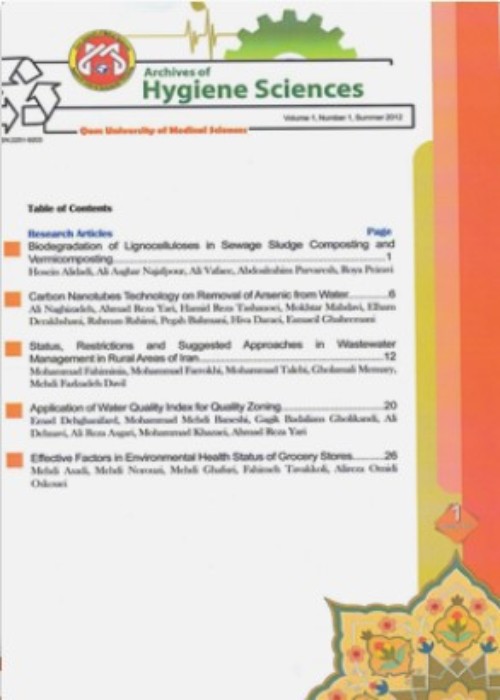Evaluating of Heavy Metal Contaminations in the Most Applicable Food Spices and Flavors in Hamedan, Iran
Author(s):
Abstract:
Background & Aims of the Study: Iranian food diet contains nutrients and herbal spices. From the most important challenges in relation to these spices is their pollution with various heavy metals. Thus, this study aims to characterize the amounts of heavy metals in collected spices from Hamedan city of Iran during 2015-2016.
Materials and Methods
180 samples of commercially accessible vegetal spices were collected from local stores all over the Hamedan city. The samples were weighted and dried in an electrical oven at 105 ±1 °C for 24 h. Then, samples were grounded to powder by a grinder. Afterwards, the samples were digested by adding 4 ml and 1 ml of concentrated nitric acid and hydrogen peroxide, respectively. After filtration of samples, flamed atomic absorption used for detection of Zinc, Copper, Iron, Nickel, Manganese, Cadmium and Lead concentrations. For the statistical analysis of the results, SPSS version 21 was used. For examining data normality, Kolmogorov-Smirnov test; to compare the mean concentration of elements between spice samples from Tukey test and in order to investigate the correlation between the average concentrations of the heavy metals in the samples, Pearson correlation test were used. Comparing mean concentration of elements with standard values was conducted, using one-sample t-test. Results
The mean concentrations of Cadmium as a toxic trace element were low in all samples and no risk threatens consumers. But, lead content in dried mint (6.04±0.85mg/kg) was high compared to the standard values. This trend was followed by cinnamon (4.88±1.32), turmeric (2.05±0.63), black pepper (1.51±0.63), sumac (1.17±1.08) and red pepper (0.72±0.85).Conclusion
Lead in dried mint exceeded the standard value whose reason can be the increase of population, mining, industrialization, transportation and usage of chemical fertilizers, leading to the spread of environmental pollution. Thus, more serious health cares and regular periodic supervisions on food spices regarding pollution with this element seem necessary.Keywords:
Language:
English
Published:
Archives of Hygiene Sciences, Volume:6 Issue: 3, Summer 2017
Pages:
268 to 275
https://magiran.com/p1717694
مقالات دیگری از این نویسنده (گان)
-
Effect of ultrasonic and infrared treatments on microbial population, physicochemical properties, and total phenols of sprouted wheat powder
Samira Amin-Ekhlas, Mohammadreza Pajohi-Alamoti *, Fakhreddin Salehi
Journal of Innovative Food Technologies, Spring 2024 -
Improvement of Physicochemical, Textural and Quality Attributes of Chicken Kebabs Using Infrared-dried Sprouted Wheat Flour
Samira Amin-Ekhlas, Mohammadreza Pajohi-Alamoti*, Fakhreddin Salehi
Nutrition & Food Technology Research, Jul-Sep 2023



